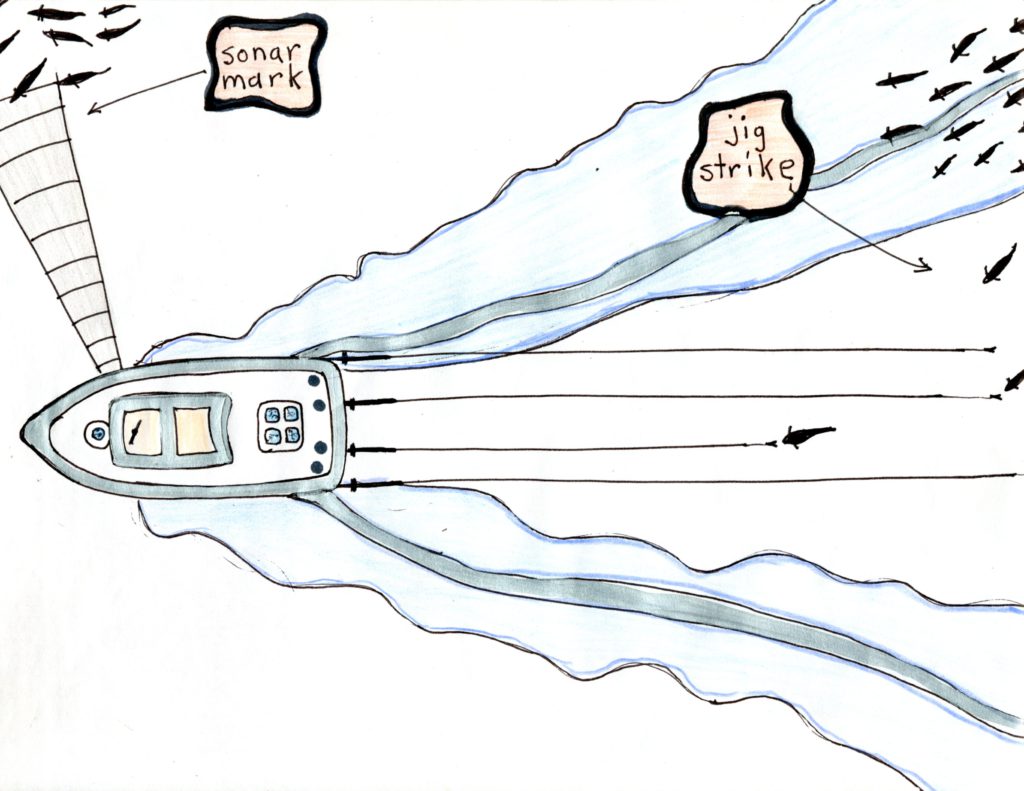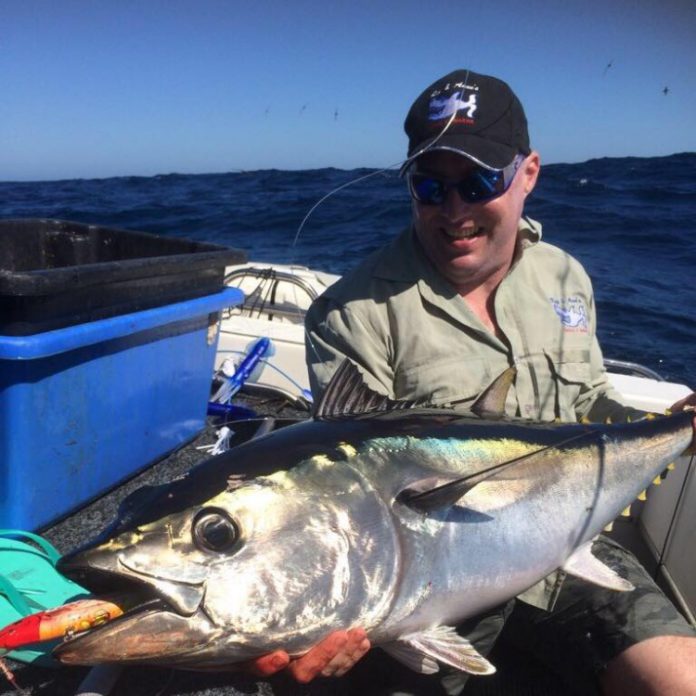Trolling minnow and guppy type baits is a proven strategy in fresh and saltwater
BY GUNDY GUNDERSON
I was on a springtime crappie trip at Lake Henshaw, a pretty little body of water in the San Diego backcountry. After a series of wet late winter storms, the lake was at a high level with lots of flooded brush on the flats. In the weeks previous, the crappie were orienting on a series of old submerged trees on the east side of the lake. Working the trees with minijigs was the way to find a school. Once located the bunched up fish were eager biters.
On this trip with the lake levels high, we found the fish were no longer on the wood and we scratched at just a handful of fish in the early morning. As we struggled, I noticed a few old timers appeared to be trolling the flooded brush on the flats. I could not help notice they kept stopping the boat. Since crappie fishermen are much more amiable and less possessive than other fisherman, I approached the two gentleman and inquired, “What are you guys doing?”
In unison they answered, “Trolling plugs.” One of the men elaborated, “The fish are scattered over the brush on this flat and trolling is much more effective to locate a school than casting.”
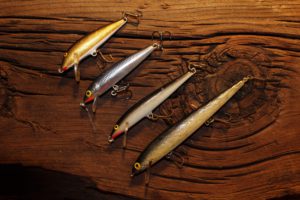
The two fishermen wound in their lures and showed me a Rebel Wee-Craw and gold and black Rapala CD-5. “We’re just working the flat.” he continued, “Once we get a bite, we fire a few crappie jigs aft and pick off another few fish before the school moves on.”
Sounds like Albacore fishing, I thought. But I saw the effectiveness of this trolling technique having employed it for years in saltwater and on eastern Sierra trout lakes. After a heartfelt thank you, we moved off and tied on our own small plugs.
It could go without saying but we crushed ‘em, catching and releasing nearly three dozen fish and a fair share of big ones. Trolling is not a universal tactic for catching crappie but it is a universal tactic for finding roaming gamefish. In this case, the lake level had flooded new areas of brush and vegetation. The crappie had scattered over the flat feeding on dislodged bug and worm life. A trolling tactic made sense.
From Pin Minnows to Marauders, in both fresh and saltwater, trolling plugs is a simple but effective technique for targeting moving, transitional and suspended fish. The characteristic of the fish often dictates whether trolling will be an effective tactic. In saltwater, pelagics, which are fish in constant motion, are the prime candidate for trolling tactics. Whether in open water or on the high spots roamers like yellowtail, dorado, tuna, wahoo, bonito and barracuda
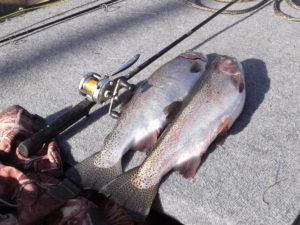
are ideal targets for trolled plugs.
Even reef fish that are more apt to stay near the structure will take a trolled plug. Species like calico bass, sand bass, halibut and in Baja waters, grouper and pargo. The tactic is also very effective in the saltwater bays, estuaries, harbors and lagoons that dot the southern California and Baja coast. Spotted bay bass, sand bass, halibut, yellowfin croaker, barracuda, shortfin or orangemouth corvina will jump all over trolled baits.
In freshwater fisheries trolling plugs will also take a variety of species. Rainbow trout and brown trout will always take a minnow-type bait. Many striped bass fishermen troll to locate roaming schools or more solitary big ones. It can be an effective crappie tactic or on in the Eastern Sierra, Sacramento perch. Whether it is roamers like trout and striped bass or suspended or moving schoolies like crappie or Sacramentos, trolling concepts and tactics should be a part of every Southern California fisherman’s arsenal.
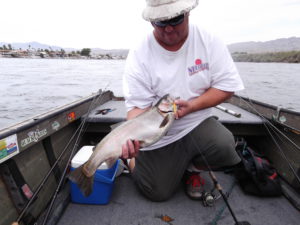
For the south coast angler, the applications are endless. They are effective along the rockslide at South Lake, over the main river channel on Lake Havasu, along the eel grass beds of Newport Harbor, in the clear cobblestone of the Cortez, along the Point Loma kelp bed, in the early morning gray on the 302 bank or on the ridges of Alijos Rocks, trolled plugs are one of the most versatile baits in fishing.
Most trolled plugs are usually minnow-type lures. Today, there are many excellent lures designed by a host of manufacturers. Each lure has its own characteristics which a seasoned angler can use to his or her advantage. Many specific baits are favored by specific species. In the old days, there were a few dozen baits to choose from. Today there are literally hundreds of bait designs. It is difficult to weed through them all. I pull my time proven favorites when I’m looking to make a catch. Once a catch is made, then I will substitute new lures into the line-up. Experimentation as I see it should come after you have a catch in the bag. Word of mouth or recommendations from other fisherman can steer you in the right direction in terms of new lures.
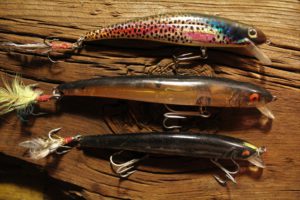
A minnow-type lure is basically a long slender design that moves through the water with minimal resistance and mimics a variety of like-size bait fish. Most have a small bill that tracks the bait straight, adds a little depth and gives the lure action. More slender baits are ideal for trolling because they track well and fish effectively at a variety of boat speeds.
For targeting deeper fish in the water column, usually in conjunction with structure, larger billed or spoon billed lures can be highly effective. These plugs are designed to meet the fish where they are holding. The drawback is that you must troll at a much slower speed and heavier tackle is required because of the increased resistance and pressure on the plug. Because they are pulled at slower speeds, many of these plugs will have larger profiles.
Another type of plug is the guppy-type baits trolled for wahoo by long range fisherman. These baits are rugged and designed for trolling offshore banks and high spots. The eye is on the top of the bait and they track like a big lipless crankbait.
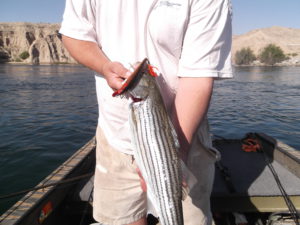
A basic rule in color selection is to match the hatch or mimic local forage fish. This is a standard approach. Additional colors not representing a specific fish but worth pulling are fire tiger, purple and black, all white, gold and black, and Halloween or black and orange.
Tackle
Trolling plugs often induce good hard strikes. Heavier tackle is usually the norm. Of course, the gear is always scaled to the species being targeted. It is usually a reaction strike so leaning toward heavier gear is a safe bet. With that said, there is a balance to strike. The general rule is that lighter line will make the plug swim deeper and give it a more lively action. The downside is that the line might not be rugged enough to endure a vicious strike, line-parting structure or a bigger fish. As you scale up in line class you will sacrifice some lure action but increase your chances of landing the fish. A balance must be struck.
Additionally, a leader, either wire, mono or fluorocarbon can help mitigate line class choices. Lighter tackle can be fished with the leader protecting from the strike or teeth of the pursued species. The leader can function in many ways. Wire, for example, is used for toothy fish like wahoo, heavy mono for reef fish like grouper or fluorocarbon for touchy brown trout.
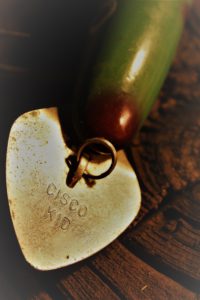
If you choose to troll with braid, consider a topshot of mono for a little stretch and shock absorption. The impact of troll strikes can be absorbed by the mono resulting in far fewer pulled hooks or short bites from the stretch-less braid.
Conventional reels tend to work best for trolling. Many are built with clickers just for this purpose. The main reason is because of the straight line from the lure to the reel making the drag much more responsive. Additionally, deploying the lure is much easier with conventional reel. When dragging light or ultra-light gear, the drawbacks of spinning reels is more negligible. Whatever reel you choose, be sure the drag is smooth and the reel is well maintained. A proper drag function at strike is critical.
Generally, a good trolling rod has a soft tip and a medium-heavy bend that shuts down toward the handle. The tip is important in reading the swim of the lure. Each lure has its own distinctive throb. If it becomes fouled by grass or debris, you’ll be tipped off by a change in the swim. The medium to heavy bend will absorb the impact of the strike and allow you to move a better fish. Again, the lure you troll, the tactic you deploy and the line class you use, will dictate best trolling rod selections.
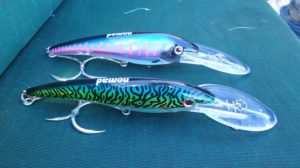
Tactics
Boat handling is everything when trolling. It is the means to present the bait to the fish in open water, approaching bird schools or covering bottom contours. In the shallows, targeting structure, weed or kelp edges, drop-offs and high spots. The best at it can maneuver the boat to drag the lures across the strike zone. Understanding the relationship of the boat to the trolled lures is key. Turning the boat and swinging the lures is a learned skill especially when fishing structure or bottom contour.
The key is to present the lure to the fish. In clear water wear polarized glasses and drive over and scout “good bottom.” Troll along kelp, weed edges and grass patches. Troll over downed timber, reef and hard bottom. Swing your lures over a bait ball or along a temperature break. Keep your eyeballs on the meter or scanning the water for fish or bird life.
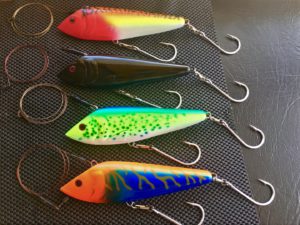
The trolling spread is important. How many rods? Two, three or four. What kind of spread? Long on the outside, short down the middle. Distance from the boat? Short spread or long spread. The species targeted, the lures deployed and the size of the boat and number of anglers will all influence the spread. The most effective spreads are usually created over time. Experience and observation are the great teachers.
Another important part of presentation is trolling speed. This is dictated by the gamefish being pursued and the lures being pulled. Many species have a preference or establish a preference. Paying attention to speeds at the strike will establish these trends. Speed variations can also trigger strikes. Some species are reactive to speed variants. Gamefish also like to bite on the turn. The lures often dig and animate. Working large s-turns or zig zags will do two things. One, it will cover a wider swath, which is especially effective when fishing drop offs. Secondly, turns will vary the speed and the baits will fish on the turn quite a bit. However, this is not the best way to fish offshore. Straight line trolling by covering lots of potentially good water is the priority.
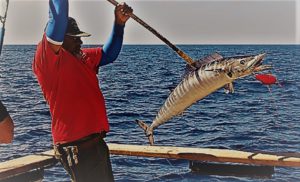
On most boats, rod holders are the standard for holding a trolling rod. They keep the spread consistent and predictable. Just be sure the trolling rod is secure on the strike. On smaller boats, at times, I like to hold the rod in my hand. This has several advantages. First, you always have a feel for your plug. A poor swimmer or fouled plug is immediately detectable. Secondly, you can work the jig. I can pump the rod like a brown trout fisherman or hold it wide to get next to a dock or weed edge. I can plunge the rod deep to take the lure down a few more feet. Another trick is to freespool the bait after a short bite. The strike often comes when you re-engage the reel.
When fishing structure with deep divers, ticking bottom occasionally is the ideal depth. I’ve rooted up some mean halibut by pulling a bait across their nose. If you drag a deep diver in water too shallow, you’ll foul the plug with mud, weeds or other debris. Understand the depth of your jig and fish it with an occasional tick of the bottom.
To make a 180 turn or work a concentrated area, use a figure eight pattern. You’ll turn slowly enough to avoid quick turn tangles. Keep the rods spread and look for tangle problems afterward. Bait balls and breaking fish can provide some fast action. Do not crash into the melee, but troll the perimeter. Quite often, you’ll get bit right there. If not, duck in behind the disturbance, turn the boat and swing the lures into the frenzy. Be ready for multiple strikes.
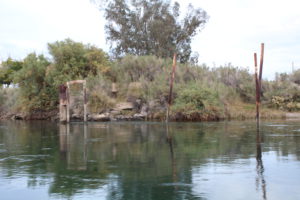
Drawbacks
There are a few things which can make plug fishing challenging and somewhat labor intensive. First, you must work with your jigs. Check them regularly for fouling. One slender piece of grass and you won’t get bit. When there is lots of flotsam and debris in the water this can be a constant. Sometimes it is prohibitive. Secondly, check the jigs for proper swim. No matter how durable, after a fish, especially a big one that hits the deck, many plugs may need tuning. This can be a tedious process. You have to drop the jig in the water, observe which way the lure tracks, then bend the eye or bill in the opposite direction. Bend not enough and it will continue in the same direction, bend too much and it will track in the opposite direction. Don’t fret, eventually you’ll get it. If the bite is on, I’ll usually yank the lure and tune it at another time when things are slower. Finally, when you are fishing bird schools, breezers or breaking fish that you must run up on before they sink out, pull the jigs then run in front of the moving spot of fish then drop the jigs back in the water. Overall, however, the advantages of fishing plugs far outweigh the limitations.
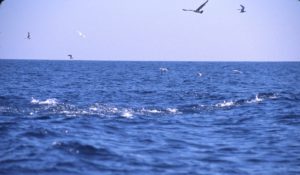
There is a heck of a lot more to trolling plugs than one might think. The nuances are endless. But if you master the skill, then you have added a valuable tool in your fish catching toolbox. One that will reliably pay dividends time after time, fish after fish.
